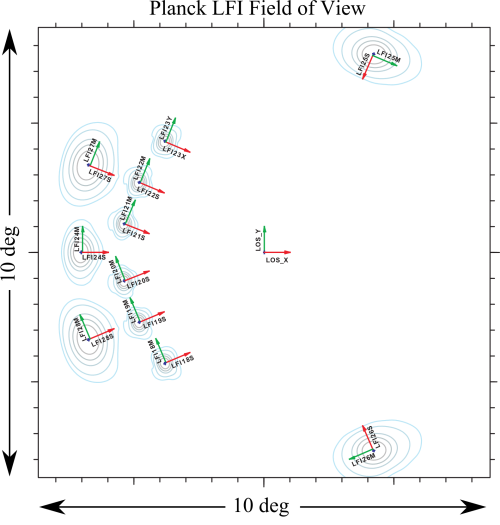Difference between revisions of "Beams LFI"
(→Overview) |
(→Main Beams and Focal Plane calibration) |
||
| Line 35: | Line 35: | ||
* THETA_UV ($\theta_{uv}$) | * THETA_UV ($\theta_{uv}$) | ||
* PHI_UV ($\phi_{uv}$) | * PHI_UV ($\phi_{uv}$) | ||
| − | |||
They are calculated starting from u,v coordinates derived form the beam reconstruction algorithm as | They are calculated starting from u,v coordinates derived form the beam reconstruction algorithm as | ||
| Line 43: | Line 42: | ||
$\phi_{uv} = \arctan(v/u)$ | $\phi_{uv} = \arctan(v/u)$ | ||
| − | + | Two additional angles are used to characterize the beams in the RIMO: | |
| − | |||
* PSI_UV ($\psi_{uv}$) | * PSI_UV ($\psi_{uv}$) | ||
* PSI_POL ($\psi_{pol}$) | * PSI_POL ($\psi_{pol}$) | ||
| − | the | + | $\psi_{uv}$ and $\psi_{pol}$ are '''not''' derived from measurements but they are extimated form '''optical simulations'''. They are the quantities that represent the polarization direction of each beam, in the following approximation: '''the M- and S- beams of the same RCA point at the same direction on the sky'''. |
| + | |||
| + | Main beams shape is characterised by 2 method: | ||
| − | + | * elliptical (or bivariate) gaussian fit. | |
| + | * Electromagnetic simulation (using GRASP Physical Optics code) by appropriately tuning the Radio Frequency Flight Model (RFFM). | ||
== Effective beams == | == Effective beams == | ||
Revision as of 08:37, 12 March 2013
Contents
Wish List[edit]
list of information to be inserted in the explanatory supplements
- Description of LFI FOV.
- Description of various telescope models as reported in the beam paper.
- Format of beam data
- Definition of various coordinate frames for beams
Overview[edit]
LFI is observing the sky with 11 pairs of beams associated with the 22 pseudo-correlation radiometers. Each beam of the radiometer pair (Radiometer Chain Assembly - RCA) is named as LFIXXM or LFIXXS. XX is the RCA number ranging from 18 to 28; M and S are the two polarization namely main-arm and side-arm of the Orthomode transducers #darcangelo2009b (see also LFI naming convention).

Main Beams and Focal Plane calibration[edit]
As the focal plane calibration we refer to the determination of the beam pointing parameters in the nominal Line of Sight (LOS) frame through main beam measurments using Jupiter transits. the parametes that characterise the beam pointing are the following:
- THETA_UV ($\theta_{uv}$)
- PHI_UV ($\phi_{uv}$)
They are calculated starting from u,v coordinates derived form the beam reconstruction algorithm as
$\theta_{uv} = \arcsin(u^2+v^2)$
$\phi_{uv} = \arctan(v/u)$
Two additional angles are used to characterize the beams in the RIMO:
- PSI_UV ($\psi_{uv}$)
- PSI_POL ($\psi_{pol}$)
$\psi_{uv}$ and $\psi_{pol}$ are not derived from measurements but they are extimated form optical simulations. They are the quantities that represent the polarization direction of each beam, in the following approximation: the M- and S- beams of the same RCA point at the same direction on the sky.
Main beams shape is characterised by 2 method:
- elliptical (or bivariate) gaussian fit.
- Electromagnetic simulation (using GRASP Physical Optics code) by appropriately tuning the Radio Frequency Flight Model (RFFM).
Effective beams[edit]
TBW
Window Functions[edit]
TBW
Sidelobes[edit]
There is no direct measurements of sidelobes for LFI. The sidelobe pattern is estimated by simulations taking into account the geometry of the telescope and the satellite structure. In figure
References[edit]
<biblio force=false>
</biblio>
(Planck) Low Frequency Instrument
Field-Of-View
LFI Radiometer Chain Assembly
Line Of Sight
reduced IMO